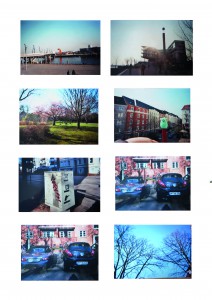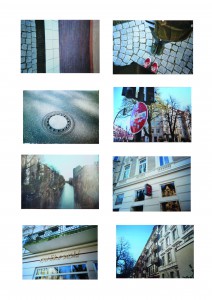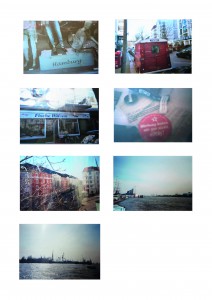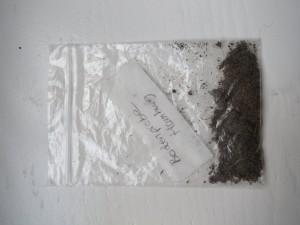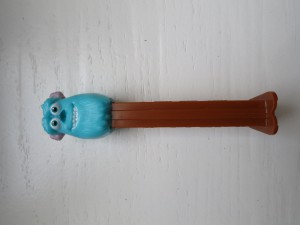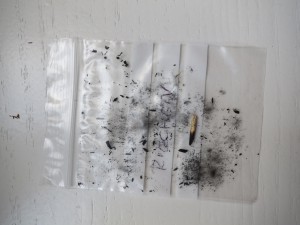Inbal Sharon’s City Kit Vol II
Concepts & Projects/ City Running
Dieses Projekt beabsichtigt das Zeitempfinden während dem Rennen zu untersuchen. Das Rennen von Strecken ist ein entscheidender Teil des Trainings für Läufer. Indem Läufer auf verschiedenen Strecken und unterschiedlichen Untergründen trainieren, vereinheitlichen und konditionieren sie ihre Lauferfahrung. Das Rennen in Städten bietet ein ganz anderes Erlebnis. »City-Running« beinhaltet keinen speziellen Untergrund. Es gibt weder Markierungen, noch vereinheitliche Routen. Nicht zu vergessen, die Luft, die Klänge und die Menschen, die von Stadt zu Stadt sehr unterschiedlich sind. In den Städten Hong Kong, Zürich und Hamburg zeichne ich verschiedene 400-Meter-Runden ein, die ich dann ablaufe. Dabei versuche ich, die Zeit zu messen, die es braucht, um eine Flasche Wasser zu trinken. Das Projekt schliesst auch ein Audioarchiv aus Bedingungen des Körpers aus der Sicht der Ich-Perspektive mit ein./ Medium: Wasserflaschen, Lautsprecherkomponenten, Kabel, MP3-Player. Dauer: ca. 30 Minuten pro Lauf.
This project aims to explore the passage of time through running. Running on tracks is an inevitable part of training for runners. It gives runners a uniform, stable, safe, convenient and almost-identical experience when runners train on different tracks in different sports grounds. On the other hand, running in the city provides a different experience. City running does not contains special flooring. There are no markers and no uniform routes. Not to mention, the air, the sounds, the people around are all very different from one city to another. By mapping various 400-metre loops in Zurich, Hamburg and Hong Kong, I ran the “tracks” and attempted to measure the time it takes to finish a bottle of water in human breath and steps. This project also involves an audio archive of the conditions of the body from a first-person perspective./ Medium: water bottles, speaker components, wire, MP3 players/ Duration: about 30 mins each
Lau Ming Wai
Concepts & Projects/ City Kit
Das City Kit wird von Stadtbewohnern in ihrer bekannten Umgebung angewendet und zeigt persönliche Eindrücke einer Stadt oder bestimmter Umgebungen. Das City Kit beeinhaltet eine Gebrauchsanleitung in Bild und Text, eine Einwegkamera, ein Notizbüchlein, ein Stift, ein USB-Stick, kleine Druckverschlussbeutel und farbige Klebepunkte. Das Kit wird an verschiedene Stadtbewohner aus Zürich, Hamburg und HongKong verteilt. Mithilfe der im City Kit enthaltenen Gegenstände ist die Person aufgefordert ihre Stadt vorzustellen und unterschiedliche Stadtteile zu untersuchen. Wenn die Stadtuntersuchung abgeschlossen ist, werden sämtliche Gegenstände wieder verpackt und nach Zürich zurückgebracht. Im Gegenzug erhalten die TeilnehmerInnen eine Impression aus einer anderen Stadt.
The City Kit is created by local city members and enables foreigners to get a personal impression of a city or certain city parts. The aim of this approach is to get impressions of some personal details or secrets about a foreign city. The City Kit includes the following items: instruction book, single-use camera, note pad, pencil, USB-Stick, little plastic bags and stickers. The City Kit is sent by postal to different participants in Zurich, Hamburg and Hong Kong. The person who receives the package is asked to introduce the city by investigating different parts of the city with the help of the Kit. Afterwards the package gets refilled and has to be sent back to the city where it came from. In return the participant will get a City-Impression of another city.
Inbal Sharon
Cities & News/ Hamburgs green surface
Der Platz in den europäischen Städten verknappt sich. Hamburg holt die Parks jetzt auf die Dächer.
In the european cities, space is a higly rare good. Now Hamburg starts to plant it’s roofs.
Concepts & Projects/ Necropolis
Städte sind gemacht, um in ihnen zu leben. Gleichzeitig gibt es in Städten Orte für Menschen, die gestorben sind: Friedhöfe. Was heisst es, den Friedhof als eine Metapher für die Stadt zu verwenden? Gibt es eine kulturelle Konstante hinter den Praktiken und den Objekten von Friedhöfen? / Medium: Tonskulptur, Soundinstallation.
City is a place for people living in. At the same time, there is a place in the city for people who passed away living in called cemeteries. What is the meaning or relationship of using cemeteries as a metaphor to the city? Is there any culture issue behind the funeral practice and objects in cemeteries?/ Medium: Sound sculpture/Sound installation
Concepts & Projects/ About the Unhappy Performers
Das Thema der Wissensarchitektur hat viele Facetten. In den Hintergrund treten hierbei meist die Rahmenbedingungen der neoliberalen Stadtproduktionsprozesse. In zwei Beispielen zeigen wir auf, wie die bewusste Platzierung von Universitätsbauten primär dazu dient, Quartiere als Invesitionsobjekte auf einem Immobilienmarkt zu profilieren. Dabei kommt den Studierenden eine besondere Rolle zu: Sie werden Projektionsflächen für Vitalität, Spontaneität und Urbanität. Der Vergleich mit dem Motiv der prämodernen Schmuckeremiten liegt dabei nahe. Aus dieser Funktion resultieren jedoch mannigfaltige Spannungsverhältnisse zwischen Forschung, Lehre, Repräsentation und Raumproduktion.
The topic of knowledge architecture is embodied in various facets. Its role in the reproduction of urban spaces is quite unreflected. We show two examples, in which the placement of a certain kind of universities in a developing borrough are primely used to emerge the value of real estate projects. A main issue is thereby the role of the students: they become a symbol for vitality, spontaneity and urbanity and are a kind of modern Schmuckeremits. Those functions may contradict with the normative role of the universities as institutions for research, education, representation and the production of space.
Frank Müller, Max Walther, Tobias Markus Strebel
Cities & News: Swiss Artist censored at Venice Biennale
Der Schweizer Künstler Christoph Büchel hatte für den Isländischen Pavillon die Kirche »Santa Maria della Misericordia« in Venedig in eine Moschee verwandelt. Ende Mai wurde Sie von den Behörden geschlossen. Provoziert hatte vor allem der Umstand, dass einige Muslime in der Kirche begonnen hatten, zu beten.
The Swiss Artist Christoph Büchel, who was invited to run the Pavillon of Iceland in Venice, transformed the Roman Catholic Church »Santa Maria della Misericordia« into a Mosque. In the end of May, the Venice government did close the church. Especially the fact that some muslims startet to use the church for prayer has caused a lot of provocation.
Concepts & Projects: Enter, Transit, Exit
Das Toni-Areal als »Stadt in der Stadt« – so wird es zumindest häufig von Architekten, Planern, nutzenden Hochschulen, aber auch Journalisten beschrieben – ist in seinen Nutzungen und Funktionen vielfältig. Die ArchitektInnen [EM2N] sprechen gar von einem »inneren Urbanismus« im Toni. Bei der Planung des Areals wurde ein besonderer Fokus auf eine starke Beziehung zwischen dem Drinnen und Draußen gelegt. Den Eingängen des Toni-Areals kommt dabei eine wichtige, jedoch auch paradoxe Rolle zu. Sie bilden gleichzeitig eine Trennung als auch eine Verbindung von/zu der Stadt. Mit welchen gestalterischen und städtebaulichen Elementen wird versucht eine Verbindung vom äußeren zum inneren Urbanismus herzustellen? Begleitet von Christopher Alexanders „Mustersprache“ und den Sichtweisen des französischen Schriftstellers Georges Perec begeben wir uns auf einen fotographisch-essayistischer Rundgang in und um das Toni-Areal…
Inaugurated in September 2014 and often described as a ‘city in the city ‘ the former industrial building Toni-Areal in Zurich West is a multifunctional building, which not only hosts the Zurich University of the Arts (ZhdK) and parts oft he Zurich School of Applied Sciences but also a concert hall, a cinema, a museum and apartments. The architects [EM2N] even grant the building an ‘inner urbanism‘. Therefore the planners put a strong focus on the relation between the interior and the exterior of the building. As a consequence the entrances and doorways play an important, but also paradoxical role; they are the connections to the city but at the same time, they also separate the inside from the outside. In our project, we explore the elements of urban design, which the architects and planners used to create the intended connection between the inner and external urban fabric and the atmosphere of these spaces? Guided by Christopher Alexander’s ‘Pattern Language‘ (1977) and the views of Georges Perec we will go on a photographic-essayistic tour through the Toni-Areal…
Julia Zofia Lerch-Zajączkowska, Lena Wolfart, Nora Unger
